Rapscallion
The Rapscallion is a looper's blade. It's a 5-ply blade with a kiri core, mahogany medial plies, and masur birch outer plies. The design uses progressively harder plies from the center to the outers. It has a noticeable flex that facilitates looping, while the hard outers allow it to perform very well for blocking and hitting, as well. This blade will suit a wide spectrum of skill levels.
The Rapscallion blades below were build using various head and handle shapes (see the Shapes page). This composition can be made with other shapes and handle styles to suit your preferences.
-
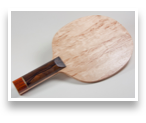
Compact-2 with ST
Ziricote/Cocobolo handle
-
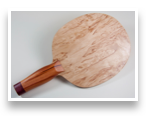
Compact-2 with Vase AN
Jobillo/Purpleheart handle
-
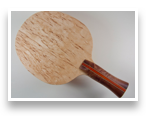
Standard-1 with AN
Camphor Burl/Chakte-Viga handle
-
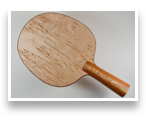
Compact-3 with Conic
Pacific Yew/Masur Birch handle
-
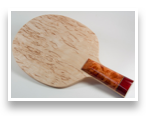
C-Pen
Amboyna burl/Bloodwood
-
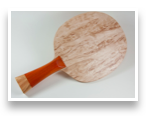
Compact-2 with FL
Chakte-Viga/Olivewood
Reviews
Your Masur really turned out to be the best of the bunch. I like to call this a looper’s delight. You almost got this perfect with the perfect wood combo (soft / med-soft/ med), the hollow in the handle create almost perfect balance and subdue all the unnecessary vibration. This is by no means a slow blade, it is more of a OFF-/OFF blade and plays in all modes (defense to power hitting) perfectly. I have tried this so far with tensor rubbers (Xiom Omega and Tenergy 05) and it plays so very well that I don’t think I need to try this with very soft or hard rubbers. I believe with medium hardness most rubber will play well with this blade. You definitely need to add this in your lineup (with only option allowed of changing the kiri core thickness so players can get the speed they want). For me now this thickness works perfectly fine and almost brings the Waldner out of me. Yesterday at the club I almost stung some 2400 level with my ferocious loops that they all wanted to see what I was playing with. Couple of them even offered to buy this blade which of course I refused. This has also ended my quest for the perfect blade temporarily.
I received the beautify blade below last week, and I used it for two training sessions and played with several friends for 3 hrs over the weekend. I would like to say that the blade realy surprised me, I had no issues adjusting to a slight reduction in speed and significant weight loss ~12 grams. The weight difference did cause me to miss several loops, but I slowed down and changed my timing, problem went away. This is my second RL blade and even though I really enjoyed the 1st blade, due to its great blocking, great control (short game, loop drives), I lost just as much in the ability to slow/medium loop - these loops had to be controlled by penetration into the rubber and slight misses resulted in significant changes in spin / speed ratio, making it inconsistent on opening loops, loop drives were outstanding, but getting to that point was trying. I play an aggressive offensive game, always looping on the FH, BH is mixed between loops / blocks and punch blocks. The blade that I have played with mostly over the last 1.5 yrs is a Nittaku Barwell, so I will give some comparisons to this blade below.
Now to the new RL Rapscallion.
Looping
This is a looping blade, generating spin was not an issue and loop drives were very easy - I felt the control was slightly better than the Barwell. The speed was good to about 5 ft from the table, anything further would need a OFF+ blade. I want to emphasize that this blade is above average for looping, with emphasis on consistency / spin and placement.
Flicking
Very good, stable and quick acceleration due to weight reduction.
Passive Blocking
Very good (surprised me). I could adsorb very heavy loops and control the placement with a soft wrist.
Punch Blocking BH only for me
This was slightly worse that the Barwell - I will need to play more before coming up with a final decision. I don't train this stroke, I just use it as part of my game, so I might need more adjustment.
Serves
The first session with the blade, I had a difficult time adjusting to the weight change, which caused inconsistent height trajectory over the net. Spin was the same, which I believe comes more from the rubbers - timing is impacted by total weight and distribution.
Serve return
Much better than Barwell. The blade has a stiffer outer ply and is less bouncy, which helps with control.
The real test came when playing with several friends, but I played mostly with a friend that is rated ~2300. We played 5 sets - 3 out of 5 - I got 4 points (much lower rated than him, but since I train with a high level player, I actually play better with higher rated players than some lower rated ones).
I won 4 out of 5 sets and several games outright, to say the least he was very surprised that I played that well and so was I. I do have to add that he could not use his BH serve, since I have seen players up to 2500 having issues with returning it, but his FH serve is no slouch either, I just can read it better.
I have played with several light blades before and never liked any of them, but I am glad that I like this one - this makes using Bluefire a breeze.
-MYTT member Metalone
Now to the new RL Rapscallion.
Looping
This is a looping blade, generating spin was not an issue and loop drives were very easy - I felt the control was slightly better than the Barwell. The speed was good to about 5 ft from the table, anything further would need a OFF+ blade. I want to emphasize that this blade is above average for looping, with emphasis on consistency / spin and placement.
Flicking
Very good, stable and quick acceleration due to weight reduction.
Passive Blocking
Very good (surprised me). I could adsorb very heavy loops and control the placement with a soft wrist.
Punch Blocking BH only for me
This was slightly worse that the Barwell - I will need to play more before coming up with a final decision. I don't train this stroke, I just use it as part of my game, so I might need more adjustment.
Serves
The first session with the blade, I had a difficult time adjusting to the weight change, which caused inconsistent height trajectory over the net. Spin was the same, which I believe comes more from the rubbers - timing is impacted by total weight and distribution.
Serve return
Much better than Barwell. The blade has a stiffer outer ply and is less bouncy, which helps with control.
The real test came when playing with several friends, but I played mostly with a friend that is rated ~2300. We played 5 sets - 3 out of 5 - I got 4 points (much lower rated than him, but since I train with a high level player, I actually play better with higher rated players than some lower rated ones).
I won 4 out of 5 sets and several games outright, to say the least he was very surprised that I played that well and so was I. I do have to add that he could not use his BH serve, since I have seen players up to 2500 having issues with returning it, but his FH serve is no slouch either, I just can read it better.
I have played with several light blades before and never liked any of them, but I am glad that I like this one - this makes using Bluefire a breeze.
-MYTT member Metalone
The blade showed up in a custom bag with a signature and a certificate of authenticity.. supercool.
The workmanship is better than any paddle i have ever owned..
I believe that Ross should charge $1,000 for this paddle but i am sure you can talk him into one for less than that :)..
His price was much lower than the paddle is worth...I felt guilty because of the care and quality to be frank.
I played with the paddle for about 7 hours saturday and Sunday this week. it hits so well its hard to explain...
I turned my newgy robot on 10 speed and pounded the racket ..and then compared it to about 6 other paddles that i own... all nice paddles (Stiga Rosewood XO - expensive paddle), as well as my andro temper tech, my butterfly Innerforce ULC, my donic black devil, and my Xiom solo....
By far, the Ross leidy was the most consistent... I would say that it is an off - or off.. my donic is an off+.
It is the most consistent and the handle is the most comfortable by far.
The racket also is the most balanced paddle i believe...
I played against others. I trained 6 hours against top ranked players.
I stood about 10 feet back from the table and looped hard with it... The blade is really consistent...
I thought..."maybe i am just having a good day" so i traded my coach hia timo boll ZLC to let him hit with it.
He kept looking at the handle in disbelief.
After 5 minutes, he handed it back to me and said: "Fast"
My chinese coach was playing with a timo boll W7 and after he played with mine... he walked over to the other side of the training center and came back with a brand new timo boll penhold ALC with Tenergy 05 on one side and hurricaine DHS on the other... and he couldn't seem to create the same speed or same control... he was soooo incredibly bothered by it... so he walked over to me and said: "How much" ... :)
THANK YOU Ross!! i have currently the best paddle in the world... unless you make another... i wouldn't sell it for $750. Not a chance... my game went up 100 points easily...
I have never hit like i did today...
-MYTT member Watchski (extracts from full review here.)
The workmanship is better than any paddle i have ever owned..
I believe that Ross should charge $1,000 for this paddle but i am sure you can talk him into one for less than that :)..
His price was much lower than the paddle is worth...I felt guilty because of the care and quality to be frank.
I played with the paddle for about 7 hours saturday and Sunday this week. it hits so well its hard to explain...
I turned my newgy robot on 10 speed and pounded the racket ..and then compared it to about 6 other paddles that i own... all nice paddles (Stiga Rosewood XO - expensive paddle), as well as my andro temper tech, my butterfly Innerforce ULC, my donic black devil, and my Xiom solo....
By far, the Ross leidy was the most consistent... I would say that it is an off - or off.. my donic is an off+.
It is the most consistent and the handle is the most comfortable by far.
The racket also is the most balanced paddle i believe...
I played against others. I trained 6 hours against top ranked players.
I stood about 10 feet back from the table and looped hard with it... The blade is really consistent...
I thought..."maybe i am just having a good day" so i traded my coach hia timo boll ZLC to let him hit with it.
He kept looking at the handle in disbelief.
After 5 minutes, he handed it back to me and said: "Fast"
My chinese coach was playing with a timo boll W7 and after he played with mine... he walked over to the other side of the training center and came back with a brand new timo boll penhold ALC with Tenergy 05 on one side and hurricaine DHS on the other... and he couldn't seem to create the same speed or same control... he was soooo incredibly bothered by it... so he walked over to me and said: "How much" ... :)
THANK YOU Ross!! i have currently the best paddle in the world... unless you make another... i wouldn't sell it for $750. Not a chance... my game went up 100 points easily...
I have never hit like i did today...
-MYTT member Watchski (extracts from full review here.)
I have played with the "Rapscallion" every single day for the last two weeks now. With a few exceptions, I have played against players at a much higher level than I currently am. The blade has been dressed with five different rubbers (T05, T6f4x, Nittaku Narucross GS Super Soft, Palio CJ8000 - Quality B,C and Globe 999, both on a 2.3 Lemon Sponge-- three more to go: TG3eNo, Sanwei T88 and Axiom Vega), and have also been played by a limited, but well-experienced and critical players.
The jury concurs that this is not a common type of blade, definitively superior to the bunch, perfect for all types of loops, and excellent for chopping, backhand and forehand drives. But since good looping blades are difficult to find, this blade should distinguish itself for assisting loopers to produce unmistakably smashing and spiny loops that would land on the opponent’s side more often than with other blades. The power it produces is comparable to Timo Boll's ZLF, but with significantly more dwell time. If compared with Timo Boll’s control blade, the blocking on the Spirit FL may score better, but only because the power and the gears in the Rapscallion are plenty more. And this is, in my view, the most interesting characteristic of the Rapscallion as I was not alone to perplex over the fact that, like the ant, this was a very light blade with a strength beyond its weight that would throw an amazing punch (it was this unexpected surprise that may have accounted for the first impression as “uncontrollable”).
Soon after feeling comfortable with the blade, I noticed its forgiving nature. I found that, much more than before, I could hit the ball standing outside of my comfortable position and still make it to the other side of the table. Hitting fast topspins on the forehand more than 50 times without a drop against the club’s coach was not possible a few weeks ago, but while holding the Rapscallion it became a benchmark I can now keep in record. And though learning appropriate position and technique were the most important reasons for this newly found control, I also have to credit the Rapscallion for its aid. In order to gauge the Rapscallion’s ability to keep the ball hitting on the table, I often moved from one blade to the other, comparing the Rapscallion with as many blades there were available at the club.
For a time I wondered how this blade could have many gears in its throw angle, throwing the ball between low and medium angles, while also allowing me to topspin it and chop it back with more precision than with other blades. It seemed incongruent to offer various shot angles while also providing the player with more control in looping or driving the ball back to the other side. This was a burning question until I became aware of two issues. One is about the way the player must use the blade and the other is about the blade’s construction.
First, the consistency of my loops and drives was closely linked to the amount of spin I applied to the ball. The more spin (mechanical or brushing), the more precise the ball fell on the table. The blade is certainly a “spinfile” and will award loopers and choppers with unbelievable. Of course, spin-less blocking was also good, so good that my drill partner would have to remind me to spin the ball back to him because it was so easy just to hold the paddle against backhand drives. Yet, more precision came from the spiny counter drives/loops I sent to the other side.
Second, from the moment I first handled the blade I noticed its uncommonly large sweet spot. This I documented by bouncing the ball on different parts of the bare blade, measuring the blade's feel and ball’s height, and by repeatedly hitting down the ball on the table around the blade’s entire bare surface while studying its vibrations and feedback. The resulting view was that the blade appeared amazingly consistent across and around: no matter where I hit the ball, it felt as if I was hitting on the middle of the blade--a rare trait indeed, which must result from the high quality of it craftsmanship. Without doubt, this expanded sweet spot accounts for its forgiving nature (attention sinners) and its ability to help the player to keep the ball in the game.
-MYTT member Caballero (extracts from full review here).
The jury concurs that this is not a common type of blade, definitively superior to the bunch, perfect for all types of loops, and excellent for chopping, backhand and forehand drives. But since good looping blades are difficult to find, this blade should distinguish itself for assisting loopers to produce unmistakably smashing and spiny loops that would land on the opponent’s side more often than with other blades. The power it produces is comparable to Timo Boll's ZLF, but with significantly more dwell time. If compared with Timo Boll’s control blade, the blocking on the Spirit FL may score better, but only because the power and the gears in the Rapscallion are plenty more. And this is, in my view, the most interesting characteristic of the Rapscallion as I was not alone to perplex over the fact that, like the ant, this was a very light blade with a strength beyond its weight that would throw an amazing punch (it was this unexpected surprise that may have accounted for the first impression as “uncontrollable”).
Soon after feeling comfortable with the blade, I noticed its forgiving nature. I found that, much more than before, I could hit the ball standing outside of my comfortable position and still make it to the other side of the table. Hitting fast topspins on the forehand more than 50 times without a drop against the club’s coach was not possible a few weeks ago, but while holding the Rapscallion it became a benchmark I can now keep in record. And though learning appropriate position and technique were the most important reasons for this newly found control, I also have to credit the Rapscallion for its aid. In order to gauge the Rapscallion’s ability to keep the ball hitting on the table, I often moved from one blade to the other, comparing the Rapscallion with as many blades there were available at the club.
For a time I wondered how this blade could have many gears in its throw angle, throwing the ball between low and medium angles, while also allowing me to topspin it and chop it back with more precision than with other blades. It seemed incongruent to offer various shot angles while also providing the player with more control in looping or driving the ball back to the other side. This was a burning question until I became aware of two issues. One is about the way the player must use the blade and the other is about the blade’s construction.
First, the consistency of my loops and drives was closely linked to the amount of spin I applied to the ball. The more spin (mechanical or brushing), the more precise the ball fell on the table. The blade is certainly a “spinfile” and will award loopers and choppers with unbelievable. Of course, spin-less blocking was also good, so good that my drill partner would have to remind me to spin the ball back to him because it was so easy just to hold the paddle against backhand drives. Yet, more precision came from the spiny counter drives/loops I sent to the other side.
Second, from the moment I first handled the blade I noticed its uncommonly large sweet spot. This I documented by bouncing the ball on different parts of the bare blade, measuring the blade's feel and ball’s height, and by repeatedly hitting down the ball on the table around the blade’s entire bare surface while studying its vibrations and feedback. The resulting view was that the blade appeared amazingly consistent across and around: no matter where I hit the ball, it felt as if I was hitting on the middle of the blade--a rare trait indeed, which must result from the high quality of it craftsmanship. Without doubt, this expanded sweet spot accounts for its forgiving nature (attention sinners) and its ability to help the player to keep the ball in the game.
-MYTT member Caballero (extracts from full review here).
